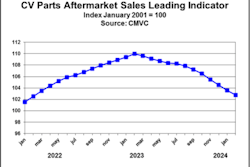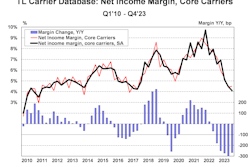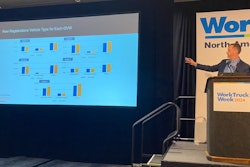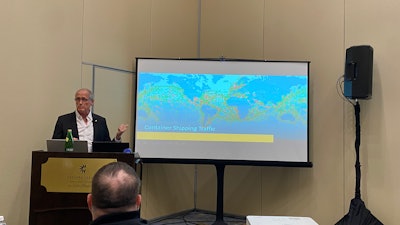
There was once a time, not that long ago, when the global supply chain was stable. Well, as stable as entity that gigantic could be. Steve Hughes said as recently as 2014 global shipping rates and carrier performance featured little variability on an annual basis.
But those days are now long behind us, and Hughes, president and CEO at HCS International, said Thursday during a presentation at the HDA Truck Pride Annual Meeting in Grapevine, Texas, they’re unlikely to come back anytime soon.
“When I think of the supply chain anymore, I think of disruptions upsetting the flow,” Hughes said. “If you think [the Baltimore bridge collapse] is the last disruption, you’re most definitely wrong.”
Hughes said the first breakdown in the global supply chain’s stability came from a labor dispute on the West Coast in 2015. That was followed by tariff battles during the Trump administration, then the pandemic, more labor disputes, a ship getting stuck in the Suez Canal, then geopolitical instability around many of the globe’s busiest waterways. Coupled with the Baltimore incident, recent weather challenges in Panama and even more lingering labor uncertainty, Hughes said it’s hard for him to imagine global shipping reaching anything close to equilibrium in the months ahead.
[RELATED: HDA Truck Pride showcases new vision statement, programs during annual meeting]
He said that’s bad news for truck parts industry shippers, because when instability hits ocean freight companies, it’s not Walmart and Target that see their rates rise. Its everyone else.
Today, Hughes views the instability in the Middle East as the biggest driver of rising ocean freight costs. Recent data indicates nearly 70% of traffic typically routed through the Suez Canal has been rerouted around the southern tip of Africa due to dangerous conditions around the canal, Hughes said, a detour that can add 7-12 days to trips and drastically increase prices. The slowdown of goods through the Panama Canal has hurt global trade as well, Hughes said, as an extended dry season around the canal has forced the nation to reduce daily traffic. North American shippers also have fears around possible strikes later this spring by the East Coast dockworkers and Canadian rail workers.
Other geopolitical challenges loom as well, such as the ongoing Russia-Ukraine conflict, and continued aggression by China in the South China Sea regarding Taiwan. Hughes said all of which motivated former U.S. Secretary of Defense Robert Gates to tell attendees at the Trans-Pacific Maritime Conference last month, “Global dangers are at a level we haven’t seen since the end of World War II,” he said.
In looking ahead, Hughes couldn’t be optimistic, but he did tell HDA Truck Pride members to enjoy period of stasis. “Rates will remain stable as long as there is no disruption, but disruption is always just around the corner.”
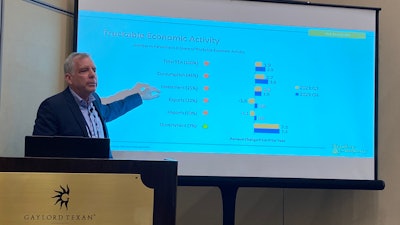 MacKay & Company's John Blodgett speaks during the HDA Truck Pride Annual Meeting Thursday in Grapevine, Texas.
MacKay & Company's John Blodgett speaks during the HDA Truck Pride Annual Meeting Thursday in Grapevine, Texas.
MacKay’s Blodgett offers economic, aftermarket forecast
Thursday’s business sessions also included a muted economic and trucking outlook report from John Blodgett of MacKay & Company.
Similar to his colleague Bob Dieli at Heavy Duty Aftermarket Dialogue, Blodgett said MacKay & Company’s research indicates the economy is in an extended boom cycle. A possible recession has been looming for a while but hasn’t yet been initiated.
Blodgett said Dieli’s Enhanced Aggregate Spread (EAS) and Truckable Economic Activity (TEA) metrics are both displaying numbers that have historically preceded recessions, but Blodgett said it's possible the pandemic has impacted those metrics somewhat, altering their predictive timelines.
[RELATED: HDA Truck Pride highlights expanded service, national accounts programs]
Blodgett also noted while the Federal Reserve hasn’t changed its Federal Funds Rate in more than half a year, that doesn’t mean inflation has been solved. Nor does it mean a recession has been avoided. Blodgett said Dieli calls this inactivity the pause after the pivot, adding a recession occurred between four and 14 months after the last three pauses.
In the aftermarket, MacKay’s forecast is less frightening. Blodgett said MacKay & Company research indicates Class 6-8 trucks and trailer aftermarket sales are up 2.9% year to date in the dealer channel and 1.4% in the independent aftermarket.
For the year, the company is still forecasting year over year growth of 4.3%, but 3% of that growth comes from higher prices. Both numbers track in range with the numbers the company first released at HD Aftermarket Dialogue.


